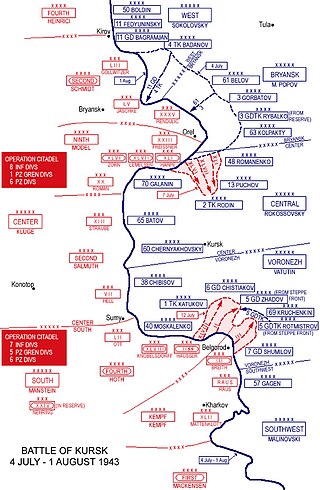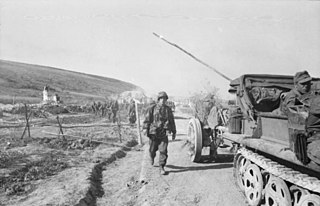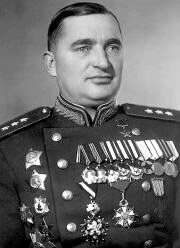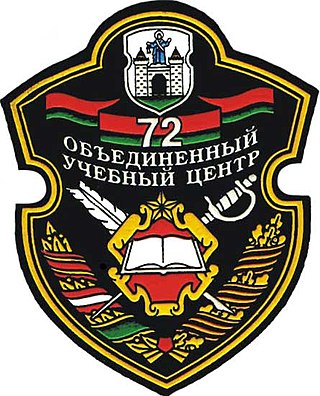Related Research Articles

The Battle of Kursk was a major World War II Eastern Front battle between the forces of Germany and the Soviet Union near Kursk in southwestern Russia during the summer of 1943; it ultimately became the largest tank battle in history and resulted in a Soviet victory. It is considered by some to be the turning point of the European theatre of war instead of the Battle of Stalingrad several months earlier.

Operation Citadel was the German offensive operation in July 1943 against Soviet forces in the Kursk salient, proposed by Generalfeldmarschall Fritz Erich Georg Eduard von Manstein during the Second World War on the Eastern Front that initiated the Battle of Kursk. The deliberate defensive operation that the Soviets implemented to repel the German offensive is referred to as the Kursk Strategic Defensive Operation. The German offensive was countered by two Soviet counter-offensives, Operation Polkovodets Rumyantsev and Operation Kutuzov. For the Germans, the battle was the final strategic offensive that they were able to launch on the Eastern Front. As the Allied invasion of Sicily began, Adolf Hitler was forced to divert troops training in France to meet the Allied threats in the Mediterranean, rather than use them as a strategic reserve for the Eastern Front. Germany's extensive loss of men and tanks ensured that the victorious Soviet Red Army enjoyed the strategic initiative for the remainder of the war.

The Battle of Korsun–Cherkassy, or the battle of the Korsun–Cherkasy pocket, was a World War II battle fought from 24 January to 16 February 1944 in the course of the Soviet Dnieper–Carpathian offensive in Ukraine following the Korsun–Shevchenkovsky offensive.

The Western Front was a front of the Red Army, one of the Red Army Fronts during World War II.

The Battle of Prokhorovka was fought on 12 July 1943 near Prokhorovka, 87 kilometres (54 mi) southeast of Kursk, in the Soviet Union, during the Second World War. Taking place on the Eastern Front, the engagement was part of the wider Battle of Kursk and occurred when the 5th Guards Tank Army of the Soviet Red Army attacked the II SS-Panzer Corps of the German Waffen-SS in one of the largest tank battles in history.
The 4th Mechanized Corps was a formation in the Soviet Red Army during the Second World War.
The 75th Guards Rifle Division was a Red Army infantry division during World War II and afterwards, which later became the 75th Guards Tank Division and was finally disbanded in the 1990s.
The Steppe Military District was a military district of the Soviet Union, formed twice. It was first formed in April 1943 during World War II near Voronezh as a strategic reserve, and after the beginning of the Battle of Kursk in July it became the Steppe Front. Postwar, the district was formed for a second time in Kazakhstan in July 1945 and demobilised troops among other duties before being disbanded in May 1946.

The Baltic strategic defensive operation encompassed the operations of the Red Army from 22 June to 9 July 1941 conducted over the territories of the occupied Lithuania, Latvia, and Estonia in response to the offensive launched by the Wehrmacht in Operation Barbarossa.

The 5th Guards Army was a Soviet Guards formation which fought in many critical actions during World War II under the command of General Aleksey Semenovich Zhadov. The 5th Guards Army was formed in spring 1943 from the 66th Army in recognition of that army's actions during the Battle of Stalingrad. The 5th Guards Army fought in the Battle of Kursk, Belgorod-Khar'kov Offensive Operation, Battle of the Dnieper, Uman–Botoșani Offensive, Lvov–Sandomierz Offensive, Vistula–Oder Offensive, Berlin Offensive, and the Prague Offensive. During the Berlin Offensive elements of the army linked up with American troops at Torgau on the Elbe. Postwar, the army was disbanded as part of the Central Group of Forces.

The Soviet order of battle for Operation Uranus details the combat units of the Soviet forces that fought in Operation Uranus, the Soviet strategic counteroffensive that led to the encirclement of the German troops in Stalingrad. The order of battle lists units present on 19 November 1942, the day the operation began, from north to south.
The 5th Guards Zimovnikovskaya order Kutuzov II degree Motor Rifle Division, named on the 60th anniversary of the USSR, was a military formation of the Soviet Ground Forces. It was formed from the 6th Mechanized Corps created in 1940 and destroyed in 1941 in the beginning of Operation Barbarossa. The corps was reformed in November 1942 under the same name, but with a different organizational structure. In January 1943, the 6th Mechanized Corps was granted "Guards" status and became the 5th Guards Mechanized Corps.
The 5th Mechanised Corps was a mechanised corps of the Red Army, formed on three occasions. It was first formed in 1934 and was converted into the 15th Tank Corps in 1938. It was reformed in the Far East in 1940 and moved west before the German invasion of the Soviet Union. It fought in the First Battle of Smolensk, losing large numbers of tanks in the Lepel counterattack. The corps was encircled in the Smolensk pocket and after breaking out was disbanded in late August 1941. Its third formation, from elements of the 22nd Tank Corps, occurred in September 1942. The corps fought in: Operation Little Saturn, Operation Gallop, the Second Battle of Smolensk, the Dnieper–Carpathian Offensive, and the Second Jassy–Kishinev Offensive. In September 1944, it became the 9th Guards Mechanised Corps.
The 70th Guards Rifle Division was formed as an elite infantry division of the Red Army in February, 1943, based on the 1st formation of the 138th Rifle Division in recognition of that division's actions during the battle, and served in that role until well after the end of the Great Patriotic War.

Aleksey Semenovich Zhadov, born with the surname "Zhidov", was a Soviet military officer in the Red Army, who during World War II commanded the 66th Army, later renamed the 5th Guards Army, from the Battle of Stalingrad up till the end of the war. For his leadership of the army, Zhadov was awarded the title Hero of the Soviet Union. Postwar, Zhadov commanded the Central Group of Forces and was deputy commander of the Soviet Ground Forces.

The Red Army's 60th Army was a Soviet field army during the Second World War. It was first formed in reserve in the Moscow Military District in October 1941, but soon was disbanded. It was formed a second time in July 1942, and continued in service until postwar. The 60th Army was commanded by Gen. Ivan Danilovich Chernyakhovsky for much of the war, and it was while in this command that he proved himself worthy to be promoted to the rank of General of the Army and command of a Front at the age of 38 years. Elements of the army went on to, among other things, liberate the Auschwitz concentration camp.

The 72nd Guards Joint Training Centre is a training centre of the Belarus Armed Forces. It trains warrant officers and junior specialists for the Belarus Armed Forces and is based in Borisov. The centre is currently led by Colonel Igor Korol. The 72nd Guards Joint Training Centre traces its history back to the Soviet 120th Rifle Division. For its actions during the Yelnya Offensive, the division became the 6th Guards Rifle Division in September 1941. In November 1945, the division became the 15th Guards Mechanized Division. On 15 May 1957, it became the 47th Guards Tank Division. The division became a training unit in 1960 and was renamed the 45th Guards Tank Training Division in 1965. In 1987, it became the 72nd Guards District Training Centre. In 1992, it was taken over by Belarus and became the 72nd Guards Joint Training Centre.
The 81st Guards Rifle Division is an infantry division of the Russian Ground Forces, previously serving in the Red Army and the Soviet Army. It was formed after the Battle of Stalingrad from the 422nd Rifle Division in recognition of that division's actions during the battle, specifically the encirclement and the siege of the German forces in the city. The 81st Guards continued a record of distinguished service through the rest of the Great Patriotic War, and continued to serve postwar, as a rifle division and later a motor rifle division, until being reorganized as the 57th Separate Guards Motorized Rifle Brigade in 2009 in the Russian Ground Forces. Most of its postwar service was in the Soviet (Russian) far east, where it was originally formed as the 422nd.

Operation Roland was a local German offensive inside the Soviet Union during the Second World War on the Eastern Front, and was conducted as a local operation within the overarching German summer offensive, Operation Citadel, on the southern side of the Kursk salient. The German forces of the III Panzer Corps and the 2nd SS Panzergrenadier Division Das Reich of the II SS Panzer Corps attempted to envelop and destroy Soviet forces of the Voronezh Front. This operation was necessitated by the failure of the German II SS Panzer Corps to break through Soviet forces during the Battle of Prokhorovka on 12 July. Therefore, German commanders decided to first link up the III Panzer Corps, which had been lagging behind due to heavy Soviet resistance, with the II SS Panzer Corps, in order to consolidate the German positions into a continuous frontline without inward bulges and enable the two panzer corps to overrun Soviet forces defending Prokhorovka together. The linking up of the two German pincers was planned to effectuate the envelopment of the Soviet 69th Army and other supporting units.
The 235th Rifle Division was an infantry division of the Red Army, originally formed in the months just before the start of the German invasion, based on the shtat of September 13, 1939. As part of the 41st Rifle Corps it was soon sent to Northwestern Front to defend the distant approaches to Leningrad. Along with its Corps the division became part of the Luga Operational Group. After Novgorod was captured the Luga Group was largely encircled and had to fight its way north toward the city, suffering considerable losses in the process. The losses to the 235th were greater than those of some others and after officially carrying on in the reserves of Leningrad Front for some time the division was officially disbanded in late December.
References
- Clark, Lloyd (2012). Kursk: The Greatest Battle: Eastern Front 1943. London: Headline Publishing Group. ISBN 978-0-7553-3639-5.
- Dunn, Walter S. (2008) [1997]. Kursk: Hitler's Gamble, 1943. Mechanicsburg, PA, USA: Stackpole. ISBN 9781461751229.
- Zetterling, Niklas; Frankson, Anders (2000). Kursk 1943: A Statistical Analysis. Cass Series on the Soviet (Russian) Study of War. London: Frank Cass. ISBN 0-7146-5052-8.
- Frankson, Anders; Niklas Zetterling (2002). "Styrkorna inför den tyska offensiven". Slaget om Kursk. Stockholm: Norstedts Förlag. ISBN 91-1-301078-6.
- Glantz, David M.; House, Jonathan M. (2004) [1999]. The Battle of Kursk. Lawrence, KS, USA: University Press of Kansas. ISBN 978-0-7006-1335-9.